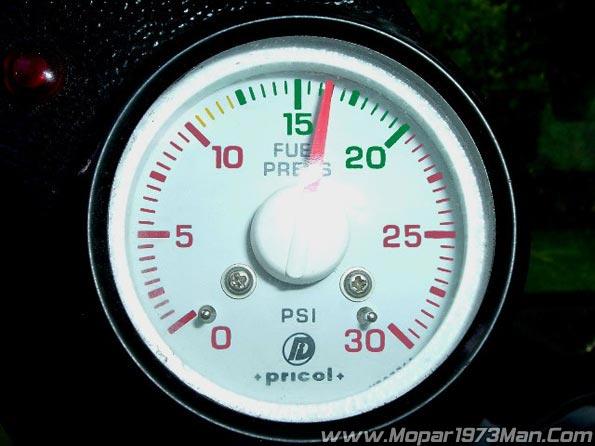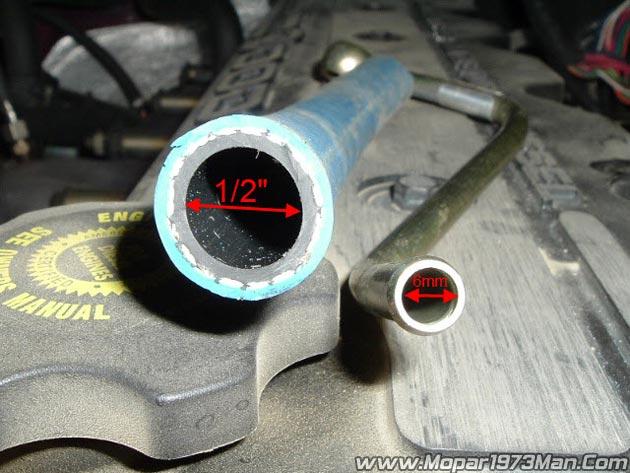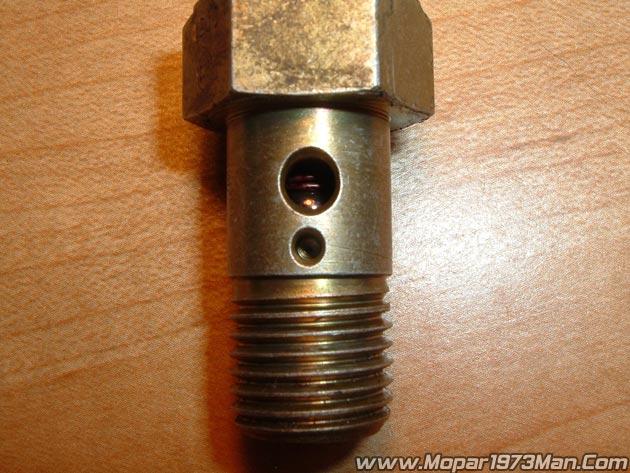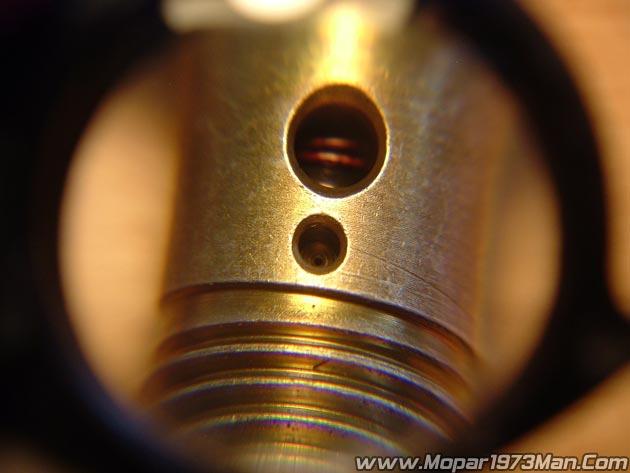Fuel Pressure Specification For Bosch VP44 Injection Pumps
Here is a copy of the fuel system specifications from the Dodge Factory Service Manual. This is for your Dodge Cummins Turbo diesel truck with a Bosch VP44 injection pump.

Fuel pressure
Normal fuel pressure should float about 14-15 PSI running down the pavement. It should never fall below 10 PSI at all. Here is a colorize fuel pressure gauge to give you a clue of the fuel pressure span you want. You want the needle to stay in the green at all times. Yellow zone is a warning that you should check the fuel filter, lift pump performance, overflow valve, etc.
This is undocumented maximum pressure is 20 PSI. Now take notice to the overflow valve is set for 14 PSI so excessive pumping of fuel does nothing for performance except create more heat in the fuel, which in turns reduces the cooling ability of the fuel and adds more stress to the lift pump. So a little extra fuel pressure is a good thing because it ensures the Bosch VP44 injection pump stays cooled and lubricated properly. However, excessive fuel pressure will heat the fuel and reduced the cooling ability of the fuel.
Now always remember that the only lubrication the Bosch VP44 injection pump will see is the fuel itself so if you don't have enough fuel pressure it will cause damage to the Bosch VP44 injection pump. It's like the same as running the engine with low oil pressure it will continue to run, but the damage to the engine will occur. On the other hand, the Bosch VP44 injection pumps, which happen to be about $1,200 to replace.

Pressure Drop
The amount of fuel pressure drop between idle and wide-open throttle. 2-3 PSI drop from idle to WOT is normal. However, 5 PSI or more pressure drop from idle to WOT is pointing out a failed lift pump, plugged filter, and/or plumbing restrictions.
2-3 PSI Is Normal Dropping more than 5 PSI is pointing towards a failed lift pump, plugged filter, or restrictive plumbing.
Just to show you the difference in the stock plumbing which is 6mm ID plumbing and most performance pumps come with 1/2" ID plumbing. These pictures will give you an idea... The first picture is a Big Line fitting over the top of the stock plumbing. Then the second picture compares the stock 6mm ID steel lines to a 1/2" ID Big Line hose.

The best way to show this example of restrictions is to let's say your house is on fire. You know your garden hose has 80 PSI of pressure, but the garden hose is only 5/8" ID hose. Your wife calls 911 and gets the fire department coming in the meantime you keep fighting the fire with your little 5/8" garden hose and losing the battle. The fire department shows up and pulls a 2 1/2" hose off the truck and charges it at 80 PSI and now winning the battle. Your fire is put out! What is so different? No matter what the size of the fuel line will dictate how much volume can be pushed through the fuel line. Like the story above the water pressure was the same at 80 PSI, but the hose size jumped from 5/8" to 2 1/2" ID hose and the volume changes are the size of hose. So the same thing applies to the stock fuel system. The stock banjo bolts and 6mm ID pipes are just too restrictive and cannot supply enough volume of fuel for that Bosch VP44 injection pump demands. This why I highly suggest you go up to 1/2" ID plumbing.
Reasons Why Fuel Pressure Is Critical

Let's take a look at a Bosch VP44 injection pump. I've labeled the fuel lines supplying fuel and return line plus the overflow valve. Now I know there is a ton of rumors on the internet of all kinds of minimum pressures for a Bosch VP44 injection pump. I'm going to say stick with the Dodge Factory Service Manual Specifications for fuel pressure. Now let's talk a bit more about the flow of the fuel. The lift pump supplies pressurized fuel to the Bosch VP44 injection pump the overflow valve regulates how much fuel pressure is held. Excessive fuel pressure is returned to the fuel tank.

The picture below is of the bleed hole in the overflow valve this image was magnified x10 to show you how small the bleed hole really is. Give you an idea the size of the hole use a single strand of 14 AWG copper wire, and it will NOT fit the hole. The bleed hole is there solely for bleeding air out of the system which air will pass through this tiny hole rather easy but fuel will not. However, if you're looking for long life from a Bosch VP44 injection pump, I would personally suggest you adjust your minimum pressure to 14 PSI this will ensure the overflow valve remain open and a constant fuel flow through the Bosch VP44 injection pump and keep it cool all the time.

Let me play out a simple scenario. Let's say my fuel pressure is roughly 10-11 PSI. I'm going to drive up into the back country approximately 40 miles with my Dodge Cummins towing an 8x8 utility trailer. Now the whole trip heading uphill into the mountain towing an empty trailer is going to be enough fuel flowing to the injectors to keep the Bosch VP44 injection pump happy. However, I've spent the day and loaded up with firewood and now coming back down the mountain loaded. I'm using my exhaust brake and coasting most of the way down taking it slow and easy. At this point, the injectors are no longer firing so the Bosch VP44 injection pump is not pumping fuel out to the injectors. Furthermore, the overflow valve closes at about 10-11 PSI so let's say it did close. Now where is the fuel going??? Nowhere! It is pooled up in the injection pump and gaining heat and being broke down. You've also removed the cooling and lubricating of the Bosch VP44 injection pump so now it actually taking on damage.
To give you a feel for the fuel flow coming from the injection pump with an AirDog 150 at 17.5 PSI of fuel pressure, I've got a video to explain that quickly.
I've heard rumors of some people trying to develop a cool down system for the Bosch VP44 Injection pump but after making the video above, there is just no way to cool down the injection pump using the lift pump of even the AirDog/FASS series. The whole problem is the restrictions inside the Bosch VP44 injection pump and the overflow valve as seen in the video above. So the only way to keep the Bosch VP44 injection pump cool is to keep fuel flowing through it at all times. So to keep the overflow valve open I suggest the 14 PSI minimum pressure. I'm currently at 136K miles on my Bosch VP44 injection pump and still going strong using a 16 PSI minimum pressure and an 18 PSI idle pressure.
Here is a short video of stable fuel pressure from 55 MPH to 70 MPH at WOT.
Here is another video done with idling, cruising, and WOT operation. Yes. I got a bit carried away and sloshed the fuel in the tank and sucked an air bubble and the pressure fell off.
Cranking Pressure Test
Here is a simple test on how to do the test for cranking fuel pressure. Pull the fuel pump relay in the PDC and then attempt to start the engine. Pay attention to the fuel pressure gauge during cranking. Be aware this test will trip a P1689 code and light the CHECK ENGINE light. Excessive cranking pressure can lead to difficult starting problems.
Suggested Lift Pump Replacement
You should replace the stock fuel system completely since it cannot supply enough fuel for even stock requirements without causing damage to the Bosch VP44 injection pump or adding stress to the lift pump. The pumps I suggest are proven and come with a lifetime warranty. These pumps come with a full kit and replace everything from the fuel tank to Bosch VP44 injection pump.
AirDog 100, 150, or 165
Raptor 100 or 150
FASS 100 or 150
FASS DDRP (DDRP Ver.2 - 89 GPH)
I don't suggest these pumps... Because they don't address the pump location, plumbing restrictions, or come with much of warranty.
Stock Carter or Carter Campaign Pump (4090046)
Holley Blue or Holley Black
FASS DDRP (DDRP Ver.1 - 40 GPH)
AirTex
Mopar's Notes: That was true for the DDRP Ver.1 However, DDRP-02 is rated at 89 GPH and will hold pressure. It is listed as a Stock replacement pump designed to perform better than the Stock pump, but not for Chips that add fueling.
I place a Power Puck on my truck with the DDRP-02 and saw no difference in FP at either idle or WOT, (PP is a timing chip doesn't change the amount of fuel).
That said the PP is currently removed from my truck as I overpowered my clutch both loaded and unloaded, back to the stock clutch is fine.
Looking for a Valair possible DD organic, or SD Kevlar/Ceramic. It is currently in the stock location and giving 15 psi at idle and 10 at WOT.
Information Provided By: rhagfo
http://www.cumminsforum.com/forum/98-5-02-powertrain/404412-fass-ddrp-02-a.html#post4197714
Additional Information (About Performance Crowds & Fuel Pressure)
I've seen several times where people will link back to performance pump builders and quoting where they say, "(Un-named) proved that 5 PSI, under load, made all the horsepower the VP44 pump could make, even with stock fuel lines, fittings and supply pump." This might be true but there is nothing ever said about the life span of the pump at these conditions. So... Please do not follow these performance crowds into destroying a perfectly good Bosch VP44 injection pump.
The fact still remains from Bosch the actual designer of the Bosch VP44 injection pump states that injection pump should return 70% of the fuel back to the fuel tank for cooling and lubrication purpose of the VP44. Being the only way a Bosch VP44 injection pump can do this is to have fuel pressure above 14 PSI to open the overflow valve. Then if the stock Bosch VP44 injection pump with an enhancement box say an Edge Comp on 5x5 can consume 15-20 GPH that means the stock 35 GPH pump cannot keep up with Bosch's design of 70% return volume. So this why products like AirDog, Raptor and FASS was created because they actually meet the demands of the Bosch VP44 injection pump. Then another fact that Bosch will let you know of is that diaphragm damage occurs from operating the Bosch VP44 injection pump at low fuel pressures. Making matters worse is that no Bosch injection re-builder will void warranty a VP44 injection pump with diaphragm damage. Dead give away that you had a bad lift pump or low fuel pressure problems.
Please view the Bosch VP44 exploded view page to see there is no diaphragm in the Revision 027 Bosch VP44 Injection Pump
Then the other fact is right from the Dodge Factory Service Manual has the minimum fuel pressures (picture at the top of the page). It even states the pressure that the overflow valve requires to open. Refer to the Overflow Valve Testing from the Dodge Factory Service Manual and see that the overflow valve should remain closed at 10 PSI and open by 14 PSI. So if the overflow valve is close by 10 PSI, then you extra cooling and lubrication just disappeared.
So ultimately it suggested having a fuel system of no less than 100 GPH supply that can maintain a minimum pressure of 14-15 PSI at WOT. This will great extend the life of the VP44 because it keeps the electronics cooler longer and keeps the rotating parts lubricated properly.
So please people let the facts and information from the actual designers of the injection pump (Bosch) and engine (Cummins) provide you proper information for your fuel system for your engine. Don't be swayed by performance shops claim of high horse output with little fuel pressure. As I proved right here doesn't work for the longevity of the VP44 injection pump...
Another thing to bring up there are people that are increasing fuel pressures above 20 PSI. Please don't do this. The return port leaving the VP44 pump isn't very big at all. The return port is on the left and supply is on the right. As you can see increasing fuel pressures above 20 PSI put you at risk for shaft seal failure. Increasing the pressure above 20 PSI isn't going to improve the return flow. I say stick with the 14-20 PSI pressure range for seal safety.

Additional Information (About Maximum Flow Rates)
Here are some calculated flow abilities of the stock fuel system vs. 1/2" big line kits. This is not calculating bend, turns, offices just straight flow for open end plumbing and this is a rough calculation.
Pipe Size Gallon Per Hour Flow Rate Gallon Per Minute Flow Rate
6mm ID pipe 75 GPH @ 15 PSI 1.2 GPM @ 15 PSI
1/2" ID pipe 570 GPH @ 15 PSI 9.5 GPM @ 15 PSI

Use The banjo bolt Shrader valve to test for fuel pressure, Item 3 in the above diagram.
If you have a 98-99 truck the port might be on top of the fuel filter housing. You can see the 90* bend fitting coming out of the top of the fuel filter housing in the below picture. Install a Shrader valve and test from there.

I'm hearing of tales of shops, mechanics, or dealers doing the old hook up the fuel pressure gauge and only checking fuel pressure at idle. This is wrong. Because I've seen lots of cases where fuel line restriction, fuel filter plugging, gelling fuel and other thing causing fuel pressure to drop out under load. Like this video from a friend of mine, you'll see he's got awesome fuel pressure at an idle (where most shops gave him the green light). However, what the shops did not test for is WOT at highway speed, and you'll see in the video, he can pull way down to 0 PSI. Anything under 14 PSI is a concern... Anything under 10 PSI is a serious problem. As for having a gauge in the cab all Dodge Cummins trucks should have a fuel pressure gauge in the cab. Because like you seen bench testing with an idle pressure is meaningless if you can't see the WOT pressure at highway speed.
-
 1
1
-
 1
1